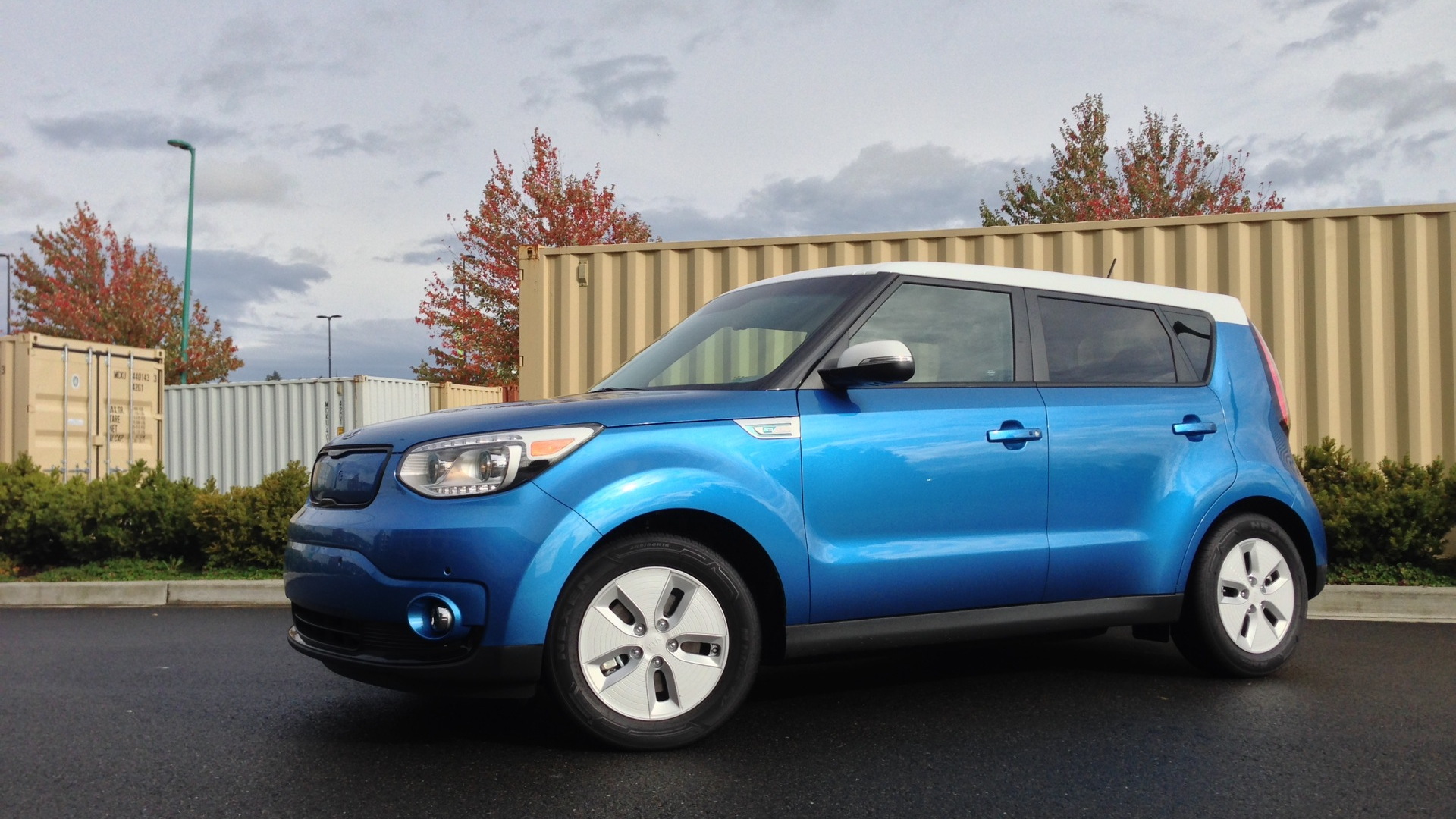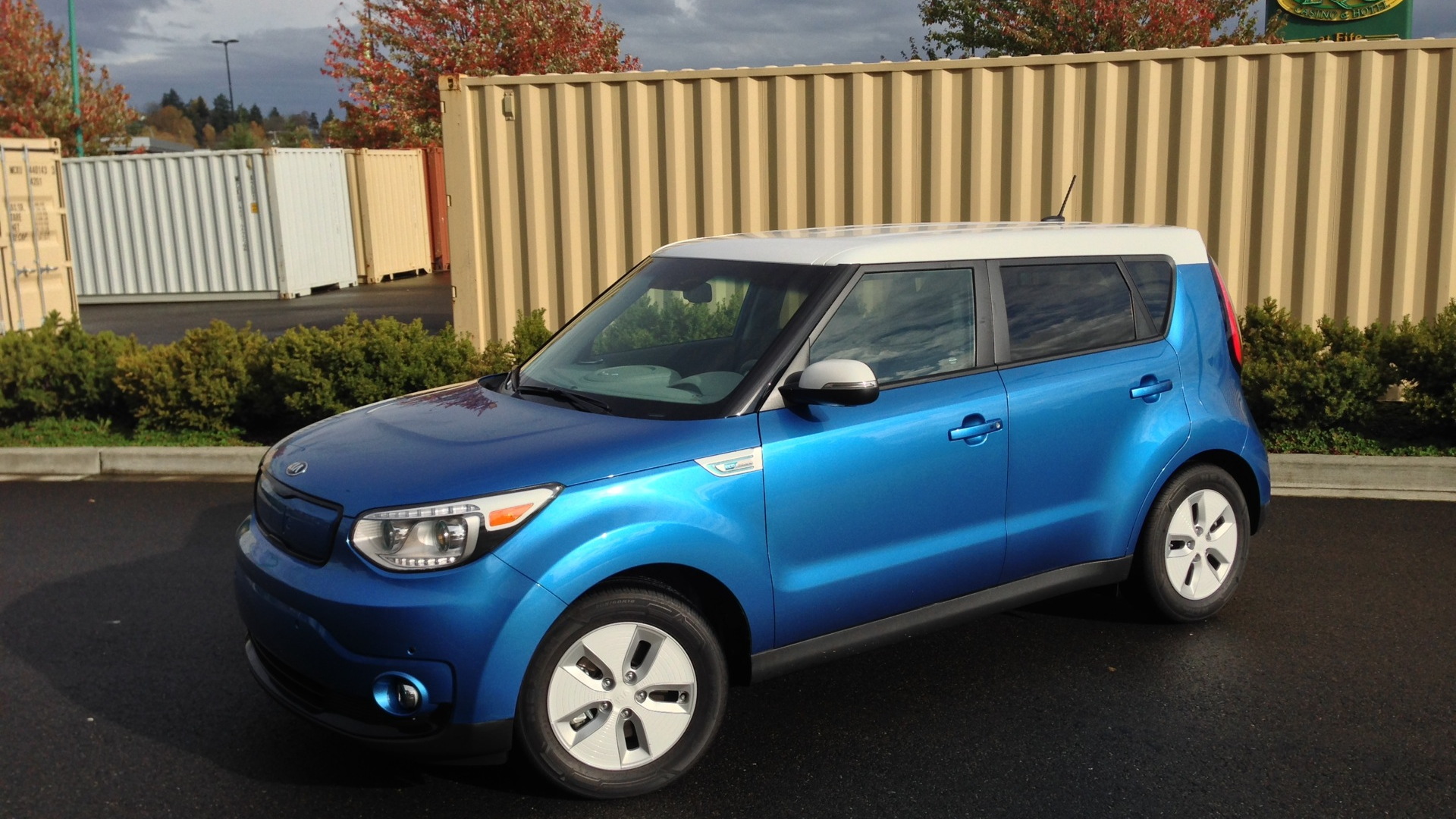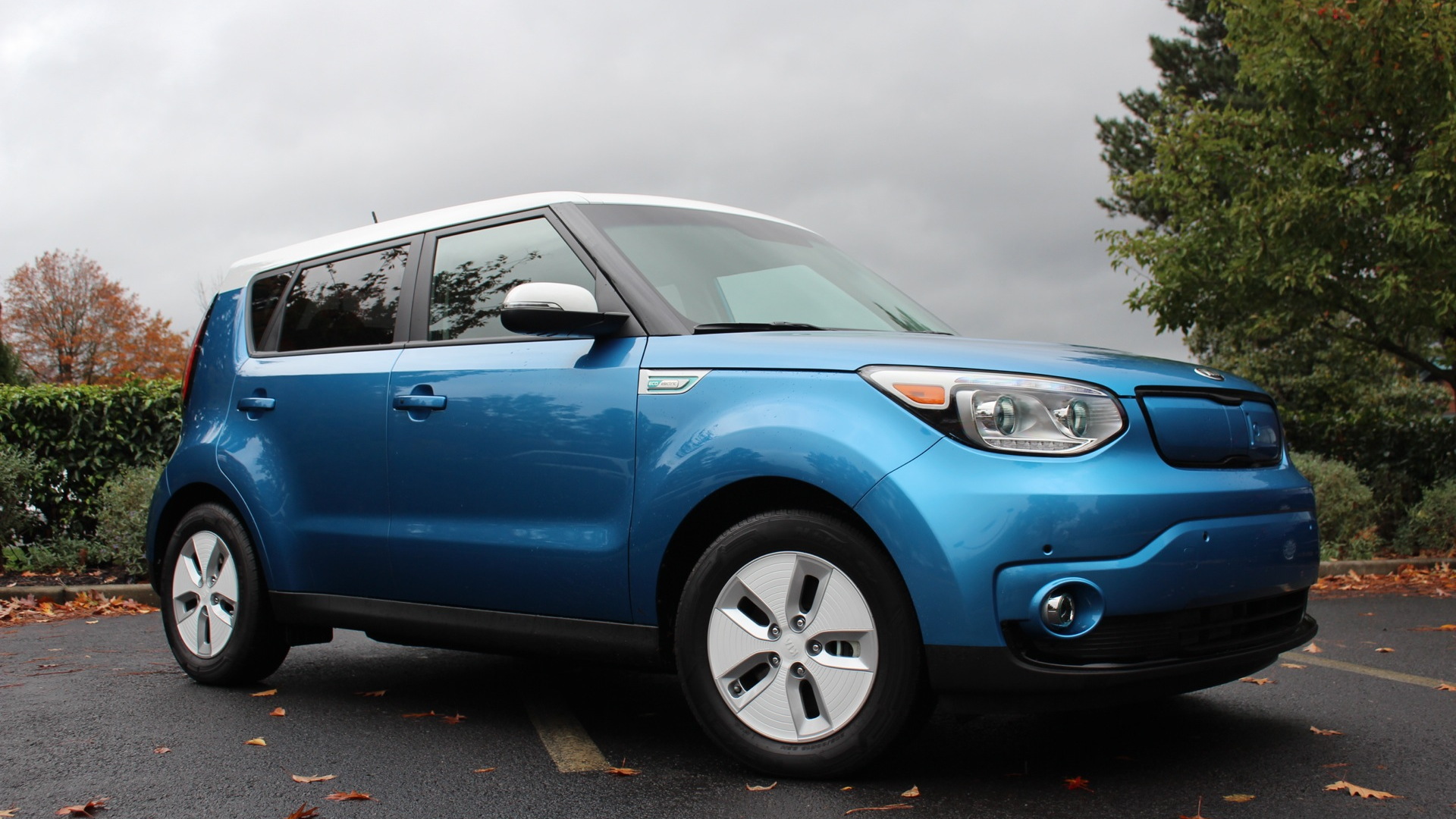The hamsters are back in Kia’s ads for its new Soul EV all-electric hatchback. And while their geeky, sexy, danceable 'science experiment' is definitely memorable, after driving the 2015 Kia Soul EV we have to wonder if perhaps the Energizer Bunny would have been a better cheer-creature.
More than any non-Tesla-badged, all-electric car so far, the Soul EV keeps going, and going, and going. To an EPA-rated 93 miles.
And it has what it takes to ease range-anxiety worries, with a predictable, even-tempered range meter that doesn’t skip a beat.
As we observed, it’s more likely to add a beat here and there, it seems. That EPA number felt quite conservative after several different charges and a total of 388 miles—split over a couple of weeks and urban, suburban, and Interstate highway driving (yes, we’ll get to that).
On the urban and suburban side, we saw 114 miles on a single charge—‘careful’ driving with no use of the main climate-control system, but not hypermiling—before we chickened out and plugged the Soul EV in. And at that point it still indicated a four-percent charge remaining.
As with all electric vehicles, using the climate-control system really chops into your remaining range. Click the system on, and the estimate will suddenly drop by 10 miles or more.
But Kia provides a couple of smart things that make it especially easy to resist the temptation to turn it on, for several good reasons. First, heated and cooled ventilated seats are included, as is a heated steering wheel, and in driving during weather in the 50s (deg F) it kept us perfectly comfortable. Secondly, there’s more flow-through ventilation here than in other models (like the Nissan Leaf, in which we’ve had multiple experiences with fogging up unless the A/C is switched back on), so you don’t have to keep cycling the defog on.
Really, it's a 100-mile electric car, at last
In short, this is a 100-mile electric car, from what we've seen—provided you can keep your driving style in check. If you can limit your driving to lower city speeds, keep your takeoffs and stops relatively smooth and gradual, and limit climate control use, you’ll likely see that or more out of a charge, with some regularity.
Even based on what we saw in highway driving, we’ll venture that if you keep your speed legal, and you use the climate control some, 80 miles is reasonable (and 70 miles is a target free of range-anxiety white knuckles and cold sweats).
Being able to go the distance is only part of the appeal here, of course. And we’re not going to put the Soul EV up on a pedestal for being racy and responsive, because it’s not. (Head for the Fiat 500e if you want to see how that’s done.)
The Soul EV is, however, a really nice-driving version of what’s already a very smart car—one that has all the packaging goodness and utility-mindedness of the gasoline Soul, but one that rides better, is more responsive, and feels a heck of a lot more refined.
With its electric motor making 109 horsepower and 210 pound-feet of torque, the Soul EV can dash to 60 mph in just under 12 seconds, according to Kia, and top speed is 90 mph; but it’s worth pointing out that, like most electric cars, it has the biggest advantage in performance over the gasoline version at low, urban-driving speeds.
Not a scorching performer, but perky where it matters
The EV feels quick but hardly scorching from a standstill, and really as strong and quick to respond as you’d need for any situation, provide you’re under about 50 mph. Above 50 mph the Soul feels just fine—with passing power that feels only as quick as the base-engine Soul (with a 1.6-liter four).
The Soul’s package itself is, we think, one that electric-car shoppers have been craving. Pretty much halfway between a subcompact car and a compact crossover, and ending up as a sort of pint-size tall wagon, the 2015 Kia Soul is about as versatile as small cars get—especially small cars that are only 163 inches long. Four adults can actually all be quite comfortable inside, and there’s enough kneeroom and headroom in back for six-footers (and those back seats are heated too, in the Plus model we had).
Any packaging changes between the Soul EV and standard Soul models are quite subtle, and Kia confirms that cargo space with the seats folded is virtually identical—minus the space taken up by the underfloor charger storage compartment. Backseat legroom is officially down three inches, but it’s not a difference you’re going to notice.
Flip the rear seats forward and the cargo floor isn’t quite flat, but it’s close enough (we moved several heavy amps, a PA, and a kick drum, and cavernous, box-like interior was easy to pack and unload).
Kia made some significant improvements to interior refinement with the Soul’s redesign this past year, and the Soul EV really makes the most of it. Just as with the gasoline Soul models, there’s a lot more insulation under the floor, soaking up road noise just as well as some much more expensive vehicles, while dramatically better materials inside help too, and modest improvements cut wind noise to a lower level than before.
Soul EV makes the most of Soul's cabin upgrades
As we noted with the gasoline car, it’s a shame engineers stopped there and didn’t think to blanket the firewall a bit more, because in those models there’s too much engine noise. Certainly not the case in the Soul EV, of course. The driving experience is almost eerily quiet at first, and there’s none of the whine during acceleration that some EV makers let through; on the other hand, you do hear the pedestrian warning sounds—part light saber, part slow-motion crickets, as a passenger put it—when you’re below 15 mph or so.
It handles better, too. Even though the Soul EV is more than 300 pounds heavier than a loaded gasoline model, it holds its mass (namely, more than 600 pounds and 27 kWh of lithium polymer hardware) lower to the ground and more evenly among the four wheels. The result is more of a ‘glued to the pavement’ feel—within reason—behind the wheel. There’s less fore-aft weight transfer, too.
The only thing it doesn’t have is much grip; in the tightest hairpin corners you’ll notice that the low-rolling-resistance tires simply won’t let you enjoy that to its fullest.
At a first-drive event last year, then in follow-up drives in Portland and New York this year, we’ve spent several hundred miles, altogether, with the standard Soul. I took the Soul EV on some of the same roads driven with the gasoline Soul, and the EV certainly rides in a more settled way, while on the highway it tracks more confidently, without the gasoline Soul’s need for small steering adjustments.
Feels comfortable coasting easy, or sharply satisfying one-pedal whims
As far as basics, the Soul EV tries to satisfy both those moving from an automatic-transmission gasoline model or an electric car. Yes it does ‘creep’ ahead—just a little bit—when you lift your foot off the brake pedal. And just in ‘D’ in normal mode, it coasts reasonably well.
Pull the shift lever back to the ’B’ setting, and there’s a lot more brake regen—to the degree that your passengers will be bobbing around if you’re not a skilled ‘one pedal’ driver. A great compromise is leaving it in ‘D’ but clicking the ‘Active Eco’ button, which softens throttle response (takeoffs are easier to modulate) and makes regenerative braking a little more...regenerative—all without putting any hamper on driving enjoyment otherwise.
Over 52 miles of particularly enthusiastic driving (as enthusiastic as we wanted to be), including some higher-speed freeway driving, rapid takeoffs, and a run up and down a favorite few miles of curvy backroad, we managed to bring a full charge down to 39 percent (and still, an estimated 33 miles remaining).
How quickly can you push those electrons back in? Using a 240V, Level 2 charger, you’ll wait five hours or less. The Soul EV also includes a CHAdeMo DC fast-charging port, allowing it to get from empty to 80-percent charge in just 33 minutes.
Fast-charge capability frees you for (leisurely) road-tripping
Now for the fun stuff. The fast-charging feature allows you to use the Soul EV, on occasion—and on very specific routes—to take this vehicle out on a highway trip. We took advantage of this capability in a 195-mile drive from Portland, Oregon, to Redmond, Washington, mostly along I-5, using some of the many chargers that are part of the so-called West Coast Electric Highway. Three stops added a total of just over an hour to a trip that would have normally been nearly three and a half hours.
The interface in the Soul EV is quite simple on the surface but more complex in ways you can order up through menus, and it feels like they got it right. Just ahead of the driver are the basics, with a stable, predictable estimated range meter, a percentage battery meter (the ‘fuel gauge’), a speedometer on the right, and an abbreviated, reconfigurable display in the middle.
All the in-depth EV features are accessed by hitting an ‘EV’ button on the center stack; that quickly brings you to a screen of EV-centric options. You can figure out where the closest charger is, for instance, or set charge times. There’s also an iPhone app for all of that, and more.
At $249 a month for 36 months, with $1,999 due at signing, the Soul EV is quite a deal. That includes the federal $7,500 tax credit, by the way.
California only? Really??
Here’s the thing: Kia is, for now, making the Soul EV available only from 17 retailers in California. For now, no other state, not even Oregon (it was forbidden fruit, for now, in this EV hub), gets the Soul EV. At this point, there’s a rollout plan for East Coast states, potentially for next spring, but it hasn’t yet been finalized.
The Soul EV has a lot going for it. With quite possibly the best usable driving range yet, relaxed but confident performance, and all the wondrous versatility, we really don’t see why the Soul EV wouldn’t sell in many more U.S. big cities.
In all, this is no science experiment, as those ads suggest. And it’s no accident or freak of nature. This is a smartly engineered electric car that offers enough range to soothe those anxieties; and wraps it into a ‘normal’ car—actually, an extraordinarily versatile ‘normal’ car that gets you off the internal-combustion hamster wheel.
_________________________________________




















